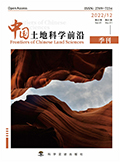

随着我国经济社会发展, 在种粮效益低下、农业生产专业化格局的形成等诸多因素影响下, 部分地区开始出现耕地“非农化”“非粮化”现象。“非粮化”在挤占我国粮食生产空间的同时, 也会对耕地产生不同程度的破坏。因此, 本文分析了新时代我国耕地“非粮化”的背景与挑战, 深入揭示了耕地“非粮化”的区域和类型差异化特征、成因及其对粮食和生态安全的影响。本文发现耕地“非粮化”的背景源于农业生产多样化和探索传统粮食作物以外的替代土地用途的需要, 并通过影响食品供给对我国粮食安全构成了挑战。未来应该探索从制度上形成长效机制, 加强“非粮化”相关政策引导, 提高耕地种粮效益以激发农民种粮积极性。文章从政策引导、多方参与、标准建设、补偿机制等多个视角提出了提升经营主体种粮意愿和防止耕地“非粮化”的对策措施, 以期为今后我国的耕地保护提供一定的借鉴意义。
With China's economic and social development, under the influence of many factors, such as the low efficiency of grain cultivation and the formation of a pattern of specialization in agricultural production, the phenomenon of “de-farming” and “de-fooding” of arable land has begun to emerge in some areas. “Non-food” in China's food production space at the same time, but also on the arable land will produce different degrees of damage. Therefore, this paper analyzes the background and challenges of the “degrading” of arable land in China in the new era, and reveals in depth the regional and typological characteristics of the “degrading” of arable land, its causes, and its impact on food and ecological security. The paper finds that the background of “non-food” cropland stems from the diversification of agricultural production and the need to explore alternative land uses other than traditional food crops, and poses a challenge to China's food security by affecting the food supply. In the future, we should explore the formation of a long-term mechanism to strengthen the policy guidance of “non-food” and improve the efficiency of arable land for food cultivation in order to stimulate farmers' incentives to grow food. The article puts forward countermeasures to enhance the willingness of business entities to grow food and prevent the “degrazing” of arable land from the perspectives of policy guidance, multi-party participation, standard construction and compensation mechanism, with a view to providing certain reference significance for the protection of arable land in China in the future.